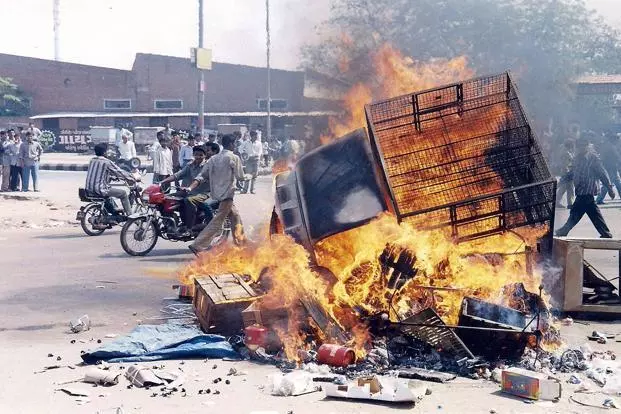
Post 2002, is Gujarat a riot-free zone? Not really, numbers suggest
Contrary to Amit Shah's claims of 'permanent peace', riots are quite frequent; only, they have shifted from urban to rural areas, and Muslims do live in fear

The demons of the 2002 riots seem to have never left the Muslims of Gujarat alone. The right-wing narrative has never let the people forget, with the riots being raked up by the BJP repeatedly.
None other than Union Home Minister Amit Shah has brought up the riots more than once in his public speeches. Only last week, speaking at a public gathering to celebrate Viksit Bharat Sankalp Yatra in Sanand gram panchayat, he mentioned how Prime Minister Narendra Modi (then Chief Minister of Gujarat) had “taught them a lesson”.
“In 2002, they created the riots,” he said, alluding the riots to a vague “them”. “Then Modisaheb taught them a lesson. Now, tell me, have there been riots in Gujarat after that? Nobody dares to cause a riot anymore,” he thundered.
“Earlier, we would have bomb blasts every day. But with one surgical air strike, we taught Pakistan a lesson. Narendrabhai has made the country safer than before,” the Home Minister added, touting the achievements of the Modi government.
Old fears sparked
Understandably, the Union Home Minister’s statement has sparked some old fears among the state’s Muslim community. “Twenty-one years after the 2002 riots, security remains the primary requirement of Muslims in Gujarat,” said Danish Qureshi, a minority rights activist and AIMIM member in Ahmedabad.
After the riots, urban ghettos like Juhapura were formed, where displaced families began to settle in, said Qureshi. And they prefer to stay out in those ghettos because that is where they feel safe. “The state still remains extremely polarised and it is still difficult for a Muslim family to sustain and earn livelihood outside the ghettos. The remarks of the Home Minister have just added to the fear,” Qureshi remarked.
This is not the first time Shah has brought up the 2002 riots in his speech at a political event in Gujarat. He made similar remarks in November 2022 while addressing a rally in Mahudha town of Kheda district.
“The anti-social elements backed by Congress were taught a lesson in 2002 and, as a result, they now stay away from such activities. The BJP established permanent peace in the state,” Shah had stated on that occasion.
Shift in riots
The Home Minister’s claims are far from true, though. Gujarat has recorded several communal riots since 2002. Their location has only shifted from urban to rural areas, according to a study by Buniyaad, a Gujarat-based minority rights organisation.
In 1946, 1969,1981-82, 1985, 1990, 1992, 2002 and 2006, major cities like Ahmedabad, Surat, and Vadodara witnessed major communal riots. Since 2002, however, places like Chattral in Gandhinagar district, Vadavali in Patan, Khambhat in Anand, Idar in Sabarkantha, and Halvad in Morbi have been recording frequent incidents of communal violence.
In April 2022, Khambhat, a coastal town in Gujarat’s Anand district, witnessed communal riots when a Ram Navami rally stopped in the Muslim-dominated part of the village and played loud, provocative music in front of the local dargah.
Before that, in February 2020, Bhavsarwad, a Hindu-dominated area in Khambhat, was looted. Following that, an Anand-based right-wing outfit called Hindu Jagran Manch organised a rally and raised provocative slogans, urging Hindus to oust Muslims from the town. Among those who raised such slogans were allegedly Sanjay Patel, a BJP leader from Khambhat and a former MLA, and Pinakin Brahmbhatt, the city unit head of the BJP.
A few days after that 2022 rally, riots broke out in Khambhat, leaving around 13 people injured, while more than 30 shops, 10 houses, and several vehicles were burnt to ashes. It took two hours for the local police and the RAF to quell the mob.
New territories
Not only have the riots shifted to rural and semi-urban areas, they are also now happening in places that were unaffected in 2002, said Hozefa Ujjaini, a minority rights activist who has been working among the riot victims in Gujarat.
“In 2019, there were six incidents of communal violence in Gujarat, of which five took place in small towns, blocks, and villages across the state. Notably, two incidents of communal riots in 2019 were caused over the issue of ‘love jihad’,” said Ujjaini.
In February 2019, a petty feud between two children over flying kites in the Akbarpura area of Khambhat turned into a communal riot. The situation turned so volatile that police had to fire seven rounds in the air and lob tear-gas shells to restore order. In the process, one policeman was injured. That same month, a small-scale communal incident occurred over a social media post about the Pulwama attack in another part of Khambhat.
In March 2017, Vadavali, a small village in Chanasma tehsil, Patan district, went up in smoke after a communal riot. Two Muslims were killed in the riots, 25 injured, and several homes gutted and looted. Noticeably, Vadavli village was not affected in the 2002 riots. Hence, many Muslim families displaced in 2002 had settled in the village.
According to Ujjaini, there are always tell-tale signs of local right-wing outfits being involved in these riots since 2022. “For instance, an outfit named Shri Ram Sena was formed about three or four years ago in Khambhat. The group has gained a lot of support in a short time,” said Ujjaini.
According to the activist, the outfit constantly spreads hate speech and distorted versions of history on social media. “They played a role in communalising a social media post on the Pulwama attack, which resulted in the riots in 2019,” said Ujjaini.

